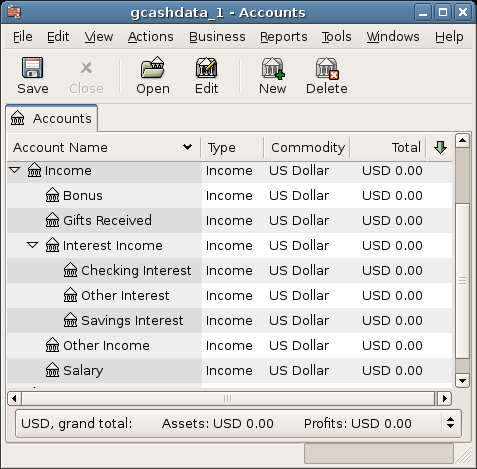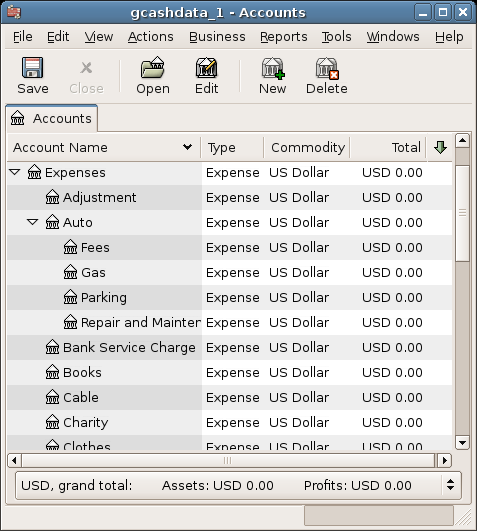This section will show how the GnuCash definition of an account fits into the view of the 5 basic accounting types.
But first, let's begin with a definition of an account in GnuCash. A GnuCash account is an entity which contains other sub-accounts, or that contains transactions. Since an account can contain other accounts, you often see account trees in GnuCash, in which logically associated accounts reside within a common parent account.
A GnuCash account must have a unique name (that you assign) and one of the predefined GnuCash "account types". There are a total of 12 account types in GnuCash. These 12 account types are based on the 5 basic accounting types, the reason there are more GnuCash account types than basic accounting types is that this allows GnuCash to perform specialized tracking and handling of certain accounts. There are 6 asset accounts (Cash, Bank, Stock, Mutual Fund, Accounts Receivable, and Asset ), 3 liability accounts (Credit Card, Accounts Payable, and Liability, ), 1 equity account (Equity), 1 income account (Income), and 1 expense account (Expense).
These GnuCash account types are presented in more detail below.
The first balance sheet account we will examine is Assets, which, as you remember from the previous section, refers to things you own.
To help you organize your asset accounts and to simplify transaction entry, GnuCash supports several types of asset accounts:
Cash Use this account to track the money you have on hand, in your wallet, in your piggy bank, under your mattress, or wherever you choose to keep it handy. This is the most liquid, or easily traded, type of asset.
Bank This account is used to track your cash balance that you keep in institutions such as banks, credit unions, savings and loan, or brokerage firms - wherever someone else safeguards your money. This is the second most liquid type of account, because you can easily convert it to cash on hand.
Stock Track your individual stocks and bonds using this type of account. The stock account's register provides extra columns for entering number of shares and price of your investment. With these types of assets, you may not be able to easily convert them to cash unless you can find a buyer, and you are not guaranteed to get the same amount of cash you paid for them.
Mutual Fund This is similar to the stock account, except that it is used to track funds. Its account register provides the same extra columns for entering share and price information. Funds represent ownership shares of a variety of investments, and like stocks they do not offer any guaranteed cash value.
Accounts Receivable (A/Receivable) This is typically a business use only account in which you place outstanding debts owed to you. It is considered an asset because you should be able to count in these funds arriving.
Asset For personal finances, use this type of account to track "big-ticket" item purchases that significantly impact your net worth. Generally, you can think of these as things you insure, such as a house, vehicles, jewelry, and other expensive belongings.
 | ティップ |
|---|---|
For all GnuCash asset accounts, a debit (left-column value entry) increases the account balance and a credit (right-column value entry) decreases the balance. (See note later in this chapter.) | |
The second balance sheet account is Liabilities, which as you recall, refers to what you owe, money you have borrowed and are obligated to pay back some day. These represent the rights of your lenders to obtain repayment from you. Tracking the liability balances lets you know how much debt you have at a given point in time.
GnuCash offers three liability account types:
Credit Card Use this to track your credit card receipts and reconcile your credit card statements. Credit cards represent a short-term loan that you are obligated to repay to the credit card company. This type of account can also be used for other short-term loans such as a line of credit from your bank.
Accounts Payable (A/Payable) This is typically a business use only account in which you place bills you have yet to pay.
Liability Use this type of account for all other loans, generally larger long-term loans such as a mortgage or vehicle loan. This account can help you keep track of how much you owe and how much you have already repaid.
 | ティップ |
|---|---|
Liabilities in accounting act in an opposite manner from assets: credits (right-column value entries) increase liability account balances and debits (left-column value entries) decrease them. (See note later in this chapter) | |
The final balance sheet account is Equity, which is synonymous with "net worth". It represents what is left over after you subtract your liabilities from your assets, so it is the portion of your assets that you own outright, without any debt. In GnuCash, use this type of account as the source of your opening bank balances, because these balances represent your beginning net worth.
There is only a single GnuCash equity account, called naturally enough, Equity.
 | ティップ |
|---|---|
In equity accounts, credits increase account balances and debits decrease them. (See note later in this chapter) | |
 | 注意 |
|---|---|
The accounting equation that links balance-sheet accounts is Assets = Liabilities + Equity or rearranged Assets - Liabilities = Equity. So, in common terms, the things you own minus the things you owe equals your net worth. | |
Income is the payment you receive for your time, services you provide, or the use of your money. In GnuCash, use an Income type account to track these.
 | ティップ |
|---|---|
Credits increase income account balances and debits decrease them. As described in 項2.1, credits represent money transferred from an account. So in these special income accounts, when you transfer money from (credit) the income account to another account, the balance of the income account increases. For example, when you deposit a paycheck and record the transaction as a transfer from an income account to a bank account, the balances of both accounts increase. | |
Expenses refer to money you spend to purchase goods or services provided by someone else. In GnuCash, use an Expense type account to track your expenses.
 | ティップ |
|---|---|
Debits increase expense account balances and credits decrease them. (See note later in this chapter.) | |
 | 注意 |
|---|---|
When you subtract total expenses from total income for a time period, you get net income. This net income is then added to the balance sheet as retained earnings, which is a type of Equity account. | |
Below are the standard Income and Expense accounts after selecting Common Accounts in the Druid for creating a new Account Hierarchy (File -> New -> New Account Hierarchy).

This image shows the standard income accounts

This image shows some standard expense accounts
 | More on Debits and Credits |
|---|---|
Remember the terms debit and credit discussed in 項2.1? Contrary to popular belief and even some dictionary definitions, accounting debits and credits do not mean decrease and increase. The only constant definition of debits and credits is that debits are left-column entries and credits are right-column entries. In fact, debits and credits each increase certain types of accounts and decrease others. In asset and expense type accounts, debits increase the balance and credits decrease the balance. In liability, equity and income type accounts, credits increase the balance and debits decrease the balance. For example, debits increase your bank account balance and credits decrease your bank account balance. Wait a minute, you might say, a debit card decreases the balance in my checking account, because I take money out of it. And when the bank gives me money back on something, they credit my account. So why is this reversed in accounting? Banks report transactions from their perspective, not yours. Their perspective is exactly opposite to yours. To you, your bank account represents an asset, something you own. To the bank, your bank account represents a loan, or liability, because they owe you that money. As explained in this chapter, asset and liability accounts are exact opposites in the way they behave. In a liability account, debits decrease the balance and credits increase the balance. When you take money out of your bank account, the balance in your account decreases. To you, this is a decrease in an asset, so you credit your bank account. To the bank, this is a decrease in a liability, so they debit your bank account. | |